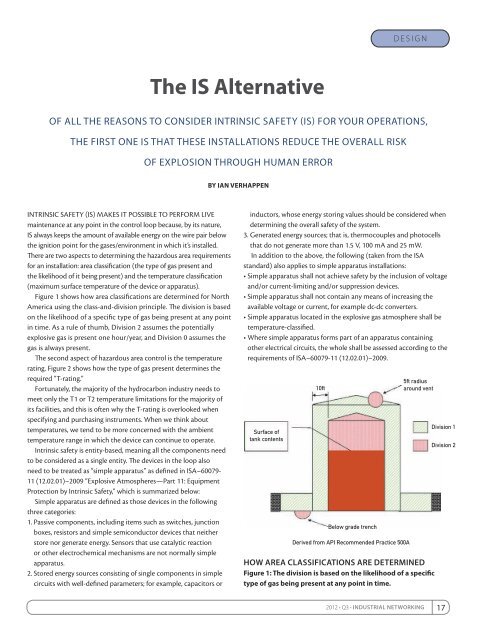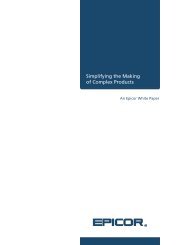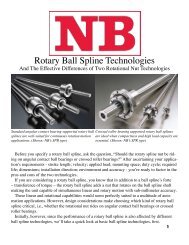ProSoft's “Phased Migration” Solutions - Control Design
ProSoft's “Phased Migration” Solutions - Control Design
ProSoft's “Phased Migration” Solutions - Control Design
Create successful ePaper yourself
Turn your PDF publications into a flip-book with our unique Google optimized e-Paper software.
DESIGN<br />
OF ALL THE REASONS TO CONSIDER INTRINSIC SAFETY (IS) FOR YOUR OPERATIONS,<br />
THE FIRST ONE IS THAT THESE INSTALLATIONS REDUCE THE OVERALL RISK<br />
INTRINSIC SAFETY (IS) MAKES IT POSSIBLE TO PERFORM LIVE<br />
maintenance at any point in the control loop because, by its nature,<br />
IS always keeps the amount of available energy on the wire pair below<br />
the ignition point for the gases/environment in which it’s installed.<br />
There are two aspects to determining the hazardous area requirements<br />
for an installation: area classification (the type of gas present and<br />
the likelihood of it being present) and the temperature classification<br />
(maximum surface temperature of the device or apparatus).<br />
Figure 1 shows how area classifications are determined for North<br />
America using the class-and-division principle. The division is based<br />
on the likelihood of a specific type of gas being present at any point<br />
in time. As a rule of thumb, Division 2 assumes the potentially<br />
explosive gas is present one hour/year, and Division 0 assumes the<br />
gas is always present.<br />
The second aspect of hazardous area control is the temperature<br />
rating. Figure 2 shows how the type of gas present determines the<br />
required “T-rating.”<br />
Fortunately, the majority of the hydrocarbon industry needs to<br />
meet only the T1 or T2 temperature limitations for the majority of<br />
its facilities, and this is often why the T-rating is overlooked when<br />
specifying and purchasing instruments. When we think about<br />
temperatures, we tend to be more concerned with the ambient<br />
temperature range in which the device can continue to operate.<br />
Intrinsic safety is entity-based, meaning all the components need<br />
to be considered as a single entity. The devices in the loop also<br />
need to be treated as “simple apparatus” as defined in ISA–60079-<br />
11 (12.02.01)–2009 “Explosive Atmospheres—Part 11: Equipment<br />
Protection by Intrinsic Safety,” which is summarized below:<br />
Simple apparatus are defined as those devices in the following<br />
three categories:<br />
1. Passive components, including items such as switches, junction<br />
boxes, resistors and simple semiconductor devices that neither<br />
store nor generate energy. Sensors that use catalytic reaction<br />
or other electrochemical mechanisms are not normally simple<br />
apparatus.<br />
2. Stored energy sources consisting of single components in simple<br />
circuits with well-defined parameters; for example, capacitors or<br />
The IS Alternative<br />
OF EXPLOSION THROUGH HUMAN ERROR<br />
BY IAN VERHAPPEN<br />
inductors, whose energy storing values should be considered when<br />
determining the overall safety of the system.<br />
3. Generated energy sources; that is, thermocouples and photocells<br />
that do not generate more than 1.5 V, 100 mA and 25 mW.<br />
In addition to the above, the following (taken from the ISA<br />
standard) also applies to simple apparatus installations:<br />
�������������������������������������������������������������������������<br />
and/or current-limiting and/or suppression devices.<br />
������������������������������������������������������������������<br />
available voltage or current, for example dc-dc converters.<br />
���������������������������������������������������������������������<br />
temperature-classified.<br />
����������������������������������������������������������������<br />
other electrical circuits, the whole shall be assessed according to the<br />
requirements of ISA–60079-11 (12.02.01)–2009.<br />
Surface of<br />
tank contents<br />
10ft<br />
Below grade trench<br />
Derived from API Recommended Practice 500A<br />
5ft radius<br />
around vent<br />
HOW AREA CLASSIFICATIONS ARE DETERMINED<br />
Figure 1: The division is based on the likelihood of a specific<br />
type of gas being present at any point in time.<br />
2012 � Q3 � INDUSTRIAL NETWORKING<br />
Division 1<br />
Division 2<br />
17















